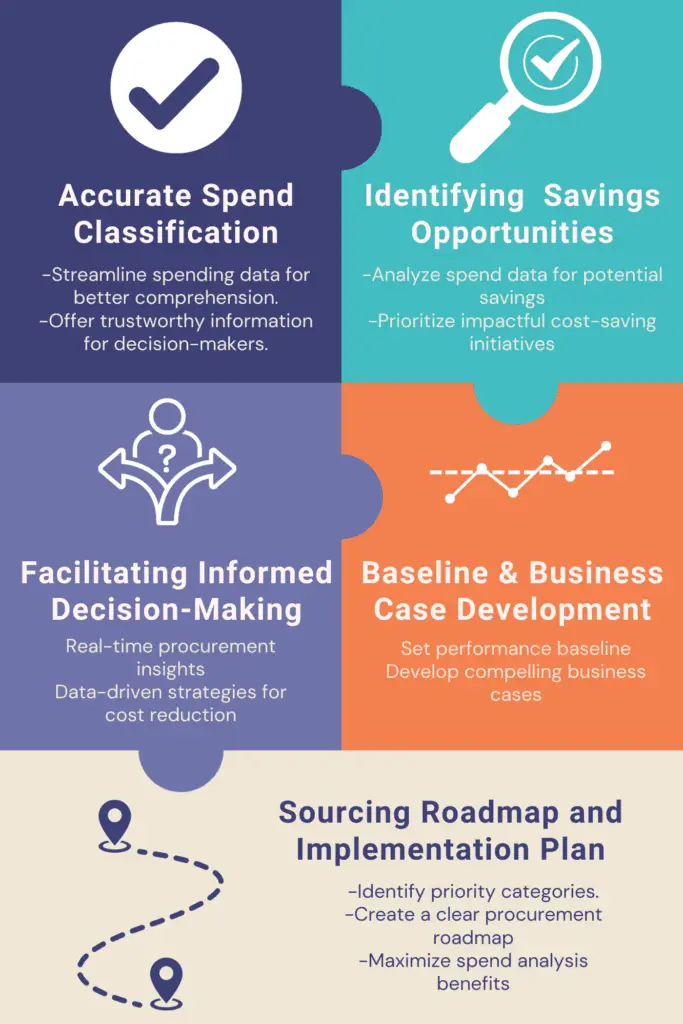
Have any questions Submit an Inquiry

Opportunity assessment is a critical component of the spend data analysis process, as it helps organizations identify categories that should be prioritized for strategic sourcing initiatives. By conducting an opportunity assessment, organizations can determine which categories have the most potential for cost savings and process improvements, ensuring that resources are allocated effectively and procurement strategies are optimized.
| # | Ease of Sourcing & Implementation | Savings Potential |
| 1 | Availability & quality of data | Potential to leverage |
| 2 | Degree of customization in design | Level of commoditization |
| 3 | Availability of suppliers/ geographical barriers | Competition in the market |
| 4 | Number of incumbent suppliers | Demand-Supply scenario |
| 5 | Time to qualify suppliers/ switching risk | Current compliance mechanism |
| 6 | Organizational sensitivity/ contractual complexity | Time since the last RFP |
Several factors contribute to the ease of sourcing and implementation for a specific category, including the availability and quality of data, the degree of customization required in design, supplier availability, geographical barriers, the number of incumbent suppliers, and the time required for supplier qualification or switching risk.
The potential savings for a category depend on factors such as the ability to leverage existing contracts, the level of commoditization, competition in the market, demand-supply scenarios, current compliance mechanisms, and the time elapsed since the last RFP.
The opportunity assessment process involves analyzing the classified spend data and evaluating categories based on the factors mentioned above. This analysis helps organizations prioritize categories that offer the most significant savings potential and are relatively easier to source and implement. Often criterion of sustainable procurement is also considered for RFP.
The steps involved in this process include:
1. Evaluating categories based on ease of sourcing and implementation factors and assigning a score to each category.
2. Assessing categories based on their potential savings and assigning a score to each category.
3. Combining the scores for each category to derive an overall prioritization score.
4. Identifying categories with the highest prioritization scores as candidates for RFPs or for challenging.
By focusing on the most promising categories, organizations can maximize their cost-saving opportunities, streamline procurement processes, and enhance overall efficiency.
Spend analysis dashboards and opportunity assessment tools enable organizations to classify their spending data accurately and efficiently. This allows for a more comprehensive understanding of procurement activities and ensures that decision-makers have access to reliable information.
By analyzing categorized spend data, organizations can identify and quantify potential savings opportunities across various levels of spending. This helps prioritize cost-saving initiatives and ensures that resources are allocated to the most impactful projects.
Spend analysis dashboards provide real-time insights into an organization’s procurement performance, enabling decision-makers to make informed choices based on data-driven insights. This helps organizations optimize their procurement strategies, reduce total cost of ownership, and improve overall efficiency.

Spend analysis tools help organizations establish a baseline of their current procurement performance, which can be used as a starting point for improvement initiatives. Additionally, these tools enable the development of compelling business cases for strategic sourcing projects, which can be used to gain stakeholder buy-in and support.
By identifying priority categories and potential savings opportunities, spend analysis dashboards and opportunity assessment tools can be used to develop a sourcing roadmap and implementation plan. This plan outlines the recommended sourcing projects and provides a clear path towards achieving procurement objectives and cost savings goals. By following this roadmap, organizations can systematically improve their procurement processes and maximize the benefits of their spend analysis efforts.
EmpoweringCPO is a team of experienced sourcing and procurement professionals with hands on experience of having worked with many fortune 500 companies. The company was founded in 2011 and since then has executed multiple strategic sourcing projects and have achieved average savings of 10-12% so far. In addition to Strategic Sourcing their other offerings are Spend Analysis, Procurement Intelligence, Procurement Analytics, Best Cost Country Sourcing, Procurement Outsourcing, Built Operate Transfer, Supplier Diversity, Sustainable Procurement, Tail Spend Management, Item Master Optimization, Collective Buying, Compliance Tracking and Managed Procurement Services.
Get A Call Back
Compliance management is very critical as otherwise the procurement organization may run into a scenario where there is a huge gap between realized savings and reported savings. Many procurement functions estimate large savings numbers when contracts are signed. They also invest significant time and effort in negotiating contracts for necessary goods and services, only to have a third or more of their purchasing dollars flow outside those deals. Some of the obvious fall-outs of non-compliance and maverick purchases are:
As compared to the current contract that was finalized after the sourcing process, the tool helps in tracking:
The objective of this tool is to ensure that the orders are placed only with the vendors that were shortlisted after the sourcing process and at the same price that was agreed upon and negotiated during and after the strategic sourcing process.